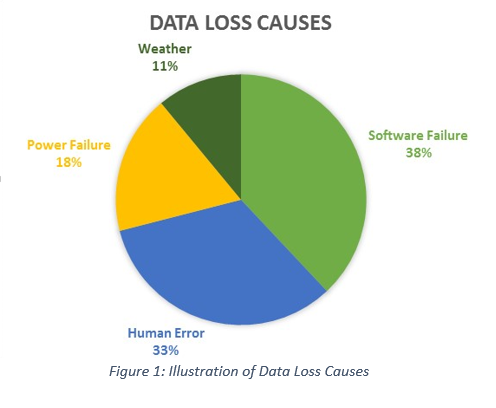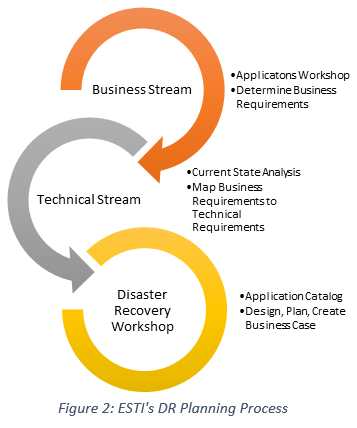 The topic of disaster recovery (DR) is not something a lot of organizations enjoy talking about. Quite frankly, it can be frightening to think of a scenario that would result in an organization not being able to access to their business critical applications. A recent study from the Disaster Recovery Preparedness Council's 2014 Annual Report stated that 3 out of 4 organizations are at risk of extended outages and critical data loss because they lack a well-developed disaster recovery plan. ESTI has the right combination of experience and technical expertise to architect and implement disaster recovery solutions. Whether your organization is seeking a recovery plan that focuses on continuous availability, sub-hour recovery time (RTO) and recovery point objectives (RPO), or just simple off-site data protection, clients can be confident that ESTI's experienced team will be there to provide a solution that satisfies all your needs.
The topic of disaster recovery (DR) is not something a lot of organizations enjoy talking about. Quite frankly, it can be frightening to think of a scenario that would result in an organization not being able to access to their business critical applications. A recent study from the Disaster Recovery Preparedness Council's 2014 Annual Report stated that 3 out of 4 organizations are at risk of extended outages and critical data loss because they lack a well-developed disaster recovery plan. ESTI has the right combination of experience and technical expertise to architect and implement disaster recovery solutions. Whether your organization is seeking a recovery plan that focuses on continuous availability, sub-hour recovery time (RTO) and recovery point objectives (RPO), or just simple off-site data protection, clients can be confident that ESTI's experienced team will be there to provide a solution that satisfies all your needs.
In January of 2012, ESTI was selected as the preferred organization to architect and implement a DR strategy for a local organization. At the time, the client was uncertain of their current  infrastructure's ability to recover business critical applications. After a review of the current infrastructure, their concern was confirmed by ESTI. The organization's storage environment was no longer meeting their needs for capacity or performance. To satisfy the needs of the client, ESTI implemented an EMC VNX storage array as the foundation of their DR strategy. Industry leading EMC Recoverpoint replication technology was integrated into the existing hardware and VMware virtualization stack. Recoverpoint provided the replication of data to their second site within the desired RPO and RTO time frames. ESTI then chose VMware's Site Recovery Manager (SRM) to manage data replication including scheduling and timing. SRM also provided the ability to determine the order applications need to be recovered in the event of a disaster scenario.
infrastructure's ability to recover business critical applications. After a review of the current infrastructure, their concern was confirmed by ESTI. The organization's storage environment was no longer meeting their needs for capacity or performance. To satisfy the needs of the client, ESTI implemented an EMC VNX storage array as the foundation of their DR strategy. Industry leading EMC Recoverpoint replication technology was integrated into the existing hardware and VMware virtualization stack. Recoverpoint provided the replication of data to their second site within the desired RPO and RTO time frames. ESTI then chose VMware's Site Recovery Manager (SRM) to manage data replication including scheduling and timing. SRM also provided the ability to determine the order applications need to be recovered in the event of a disaster scenario.
Once the implementation was successfully completed, ESTI turned focus to quality assurance (QA). The QA process tested the organization's ability to perform a full-scale recovery. Testing demonstrated that all services could be migrated from the primary site to the secondary site in less than an hour. The client then operated at the secondary site for several days before using the reverse replication features to fail back to their primary site in under an hour and resume normal operations to complete the DR initiative.
Since implementing the DR plan, the client IT team has gained the freedom and confidence to focus on strategic business initiatives and drive the organization forward. Fostering internal capabilities and leveraging external partnerships has provided opportunity for this to happen.

Recently, ESTI has partnered with the same organization to further strengthen their backup and recovery strategy. The organization was experiencing significant data growth driven by new business initiatives. This growth in data was applying pressure to the organization's backup environment. After further review of the organization's current environment, ESTI proposed EMC's Data Domain solution to facilitate the increased growth in data. ESTI expects that the organization will benefit from high deduplication rates, which will result in less storage infrastructure being required now and into the future. The organization's DR strategy was strengthened by Data Domains' ability to replicate to one another between the primary and secondary sites.
If your organization is currently operating without a strategic DR plan, please contact the account management team at sales@esti.ca to take the first step towards protecting your organization against the uncertain.
 The topic of disaster recovery (DR) is not something a lot of organizations enjoy talking about. Quite frankly, it can be frightening to think of a scenario that would result in an organization not being able to access to their business critical applications. A recent study from the Disaster Recovery Preparedness Council's 2014 Annual Report stated that 3 out of 4 organizations are at risk of extended outages and critical data loss because they lack a well-developed disaster recovery plan. ESTI has the right combination of experience and technical expertise to architect and implement disaster recovery solutions. Whether your organization is seeking a recovery plan that focuses on continuous availability, sub-hour recovery time (RTO) and recovery point objectives (RPO), or just simple off-site data protection, clients can be confident that ESTI's experienced team will be there to provide a solution that satisfies all your needs.
The topic of disaster recovery (DR) is not something a lot of organizations enjoy talking about. Quite frankly, it can be frightening to think of a scenario that would result in an organization not being able to access to their business critical applications. A recent study from the Disaster Recovery Preparedness Council's 2014 Annual Report stated that 3 out of 4 organizations are at risk of extended outages and critical data loss because they lack a well-developed disaster recovery plan. ESTI has the right combination of experience and technical expertise to architect and implement disaster recovery solutions. Whether your organization is seeking a recovery plan that focuses on continuous availability, sub-hour recovery time (RTO) and recovery point objectives (RPO), or just simple off-site data protection, clients can be confident that ESTI's experienced team will be there to provide a solution that satisfies all your needs. infrastructure's ability to recover business critical applications. After a review of the current infrastructure, their concern was confirmed by ESTI. The organization's storage environment was no longer meeting their needs for capacity or performance. To satisfy the needs of the client, ESTI implemented an EMC VNX storage array as the foundation of their DR strategy. Industry leading EMC Recoverpoint replication technology was integrated into the existing hardware and VMware virtualization stack. Recoverpoint provided the replication of data to their second site within the desired RPO and RTO time frames. ESTI then chose VMware's Site Recovery Manager (SRM) to manage data replication including scheduling and timing. SRM also provided the ability to determine the order applications need to be recovered in the event of a disaster scenario.
infrastructure's ability to recover business critical applications. After a review of the current infrastructure, their concern was confirmed by ESTI. The organization's storage environment was no longer meeting their needs for capacity or performance. To satisfy the needs of the client, ESTI implemented an EMC VNX storage array as the foundation of their DR strategy. Industry leading EMC Recoverpoint replication technology was integrated into the existing hardware and VMware virtualization stack. Recoverpoint provided the replication of data to their second site within the desired RPO and RTO time frames. ESTI then chose VMware's Site Recovery Manager (SRM) to manage data replication including scheduling and timing. SRM also provided the ability to determine the order applications need to be recovered in the event of a disaster scenario.


_5d7ac7878f74b0_52802491.png)

